|
|
Obesity, weight loss, elderly home care, fitness.
|
|
Soccer, handball, fitness, aerobics, dancing, training.
|
|
Playground, Interior design, creativity and learning.
|
|
|
Health

The modular interactive tiles for rehabilitation are designed to motivate patients to perform specific physical actions. Specifically, the goal is for the patients to become motivated to perform the actions needed for the recovery of their abilities. Often, rehabilitation is tedious and monotonous, which may be the case both for physical rehabilitation and also for general fitness training.
With the modular interactive tiles, rehabilitation training becomes interesting and fun, since the interaction is like a play where people forget that they are doing exercises and find the activity fun, challenging and playful. By allowing the modular tiles to respond in an appropriate manner to the patients’ physical movements, the equipment is creating playful experiences for the patient, and the play motivates people to perform and forget the surrounding environment, e.g. a hospital setting.
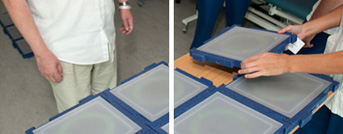
|
The tiles are a playful modular device that motivates to perform physical activities, and it is of benefit as a motivating tool for physiotherapeutic rehabilitation practices. Due to the game play, the interactivity, and the progress monitoring, patients become highly motivated to engage in and perform physical rehabilitation exercises.
The unique modularity of the tiles allow to easily reconfigure the tool to suit individual patients and different patient groups, e.g. cardiac and stroke patients, since the modular tiles in an easy and flexible manner can be moved around and configured for different activities.
The modular interactive tiles have been tested for an extensive period of time (3 years) in daily use in a hospital rehabilitation unit e.g. for cardiac patients, and in rehabilitation center. Also, the tiles were tested for performing physical rehabilitation of stroke patients in their private home. In all pilot test cases qualitative feedback indicate that the patients find the playful use of modular interactive tiles engaging and motivating for them to perform the rehabilitation.
Also, test data show that some playful exercises on the tiles demand an average heart rate of 75% and 86% of the maximum heart rate.
|
Stroke patients

Background:
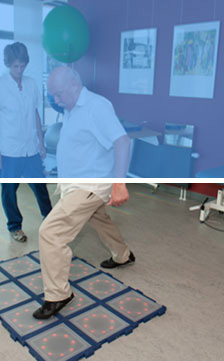
Cardiovascular diseases including stroke are strongly correlated to age and are foreseen to be the leading cause of disablement among the elderly in the years to come. 90% of stroke patients are older than 60 years. European Governments aim to raise the average age for leaving work force, but this may be difficult to implement because the number of people who are forced to stop working prematurely due to stroke and other cardiovascular diseases is set to double over the next 25 years. Stroke is the most important cause of morbidity and long-term disability in Europe and imposes an enormous economic burden. The prevalence of European citizens now suffering from stroke is estimated at 1.13 million people. Lifetime costs per patient after a stroke span from $73,000 in Sweden to $37,000 in the Netherlands.
Stroke is a cerebrovascular accident, caused by an interruption of blood supply resulting in neurological injury and damage to the brain. This medical emergency can cause significant physical, mental and emotional impairments as well as permanent disability and even death if not promptly diagnosed and treated.
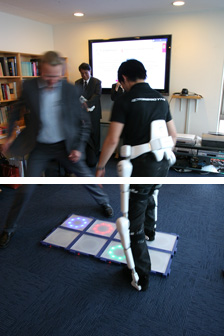
Common consequences of stroke includes weakness or paralysis of one side of the body, balance problems, vision impairments, speech disorders and problems with attention span, memory loss and problem solving. Two weeks after a stroke up to 60% of patients require some assistance daily, while 40% of stroke patients need active rehabilitation services. It is recommended that active rehabilitation should be administered to the patients as long as objective improvement is observed in their neurological function. However, current standard multi-disciplinary stroke rehabilitation treatment is labour-intensive, requiring one-to-one manual interactions with therapists. One-to-one physiotherapy and speech therapy have been the traditional rehabilitation. These are expensive treatments compounded by the fact there is already a shortage of trained physio- and speech therapists in most countries. Therefore it is difficult to provide highly intensive treatment for all patients. The result is that when treatment is reduced or stopped and the patient is left to continue unsupervised, the functions deteriorate. According to Roth and Harvey, patients can benefit greatly from training in therapeutic environments that reflect their natural homes or communities. In this environment the training effort can be focused and the patient will be less distracted by external stimuli. Early discharge from hospital after a stroke incident with rehabilitation at home has shown to be beneficial for patients being mildly to moderately impaired. An early
discharge will also reduce the cost of hospitalization.
Solution:
The modular interactive tiles aim to provide more and better stroke rehabilitation. The temporary service may be limited to the period of rehabilitation (as opposed to assistive services) and aim at minimizing the dependencies on assistive services after stroke and restore the stroke victims to an active life again.
The modular interactive tiles make remote rehabilitation possible in the users’ home or at a local centre. The system is generic enough to enable the user and health care personnel to set up the tiles as a rehabilitation device for physiotherapy.
At any time the user have the opportunity to change rehabilitation solution due to his changed needs or preferences without having to change any of the underlying technology set-ups, and without having to deal with another user interface. The modular interactive tiles enable the user to exercise training independently of the therapists, and if motivated attain large quantities of training. The applications allow monitoring of user progress, which is relevant for the healthcare therapist to continue to supervise rehabilitation in an efficient way.

A number of games for the modular robotic tiles are used for physiotherapeutic rehabilitation of cardiac patients who have undergone surgery and need to perform rehabilitation. Typically, the cardiac patient needs to perform actions to reach a pulse level which may increase over the patient’s recovery period. The games and tiles are easily reconfigured by the physiotherapist or the patients themselves to increase or decrease the pulse level. For instance, a game on a larger surface with more tiles may enforce a higher pulse level. Due to the modularity of the tiles, adding or removing tiles to make larger or smaller surfaces is done within seconds. The games for cardiac patients include, amongst many others, Color race, Lunges, Stepper, and Disco.
The tiles are used in the rehabilitation gym (e.g. at the hospital) along with traditional equipment such as an exercise bike and a treadmill, and physiotherapist Pedersen (hospital Sygehus Fyn Svendborg) concludes that “it is much more fun to exercise on the tiles. Patients forget the physical work when the lights flash and the
game is on”.
See Scientific Evidence for hospital tests with cardiac patients.
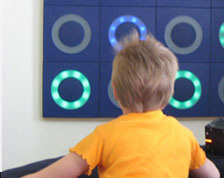
|
The modular interactive tiles are used also by physically impaired people. For instance, the soccer game is used as a handball game by people in wheelchair. The tiles are used for physiotherapeutic training of impaired children, even in places like Africa (e.g. at the Neema physiotherapists in Iringa, Tanzania), where the modularity allows the physiotherapists and carers to easily set up individual training and gaming experiences appropriate to the individual child.
Also, the modular interactive tiles are used in Children's hospitals in multi-sensory rooms for impaired children.
The modular tiles can, for instance, also be placed in the parallel walking bars, so that people with walking difficulties can play the games while holding on to the walking bars and thereby obtain fun and motivating training in the parallel walking bars. Also, the modular interactive tiles can be used as a motivating walking training tool for learning to use helping tools such as sticks, walking frame, and robotic prostheses. In all cases, the modular interactive tiles provide truly fun and challenging training.
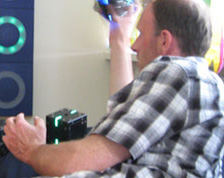
|
Modular interactive tiles are used as playful, interactive tools for children with autism. We believe that under some circumstances with the right kind of interactive play tools in the form of playware, children with autism may actually be able to practice and enjoy construction play. As outside observers, we may view their constructive play activity as stereotypic, but at the same time it is evident that there are clear individual differences in the way the children confront and perform the construction play with interactive tiles.
By allowing children with autism to engage in free play with modular interactive tiles, it may be possible to learn something about the children, for instance by observing how the individual child is constructing and interacting with the modules. Indeed, research is performed to investigate how the intelligent hardware and software of the modular interactive tiles may automatically provide information on individual modes of interaction. Using artificial neural networks for automatic classification of the individual construction practices, we may compare this classification with the diagnosis of the children, and possibly obtain a supplementary diagnosis tool which is based on the autistic children’s free play with the modular interactive tiles. Also, imitation experiments with the interactive tiles for autistic
children are performed at Hospetal de la Salpetriere, Paris, France. |
Home Care

Staying as long as possible in the private home instead of going to hospitals or elderly care homes improves quality of life. A box of modular interactive tiles can be used for home care in any private
home, since it can easily be transported to the home, stored in the home, and set up e.g. in the living room within one minute. The modular tiles are simply put together, and then an elderly can immediately start doing exercise games in the private home, instead of going to the hospital or the rehabilitation center. The elderly or the patient can perform the exercises at home either as a means of prevention or as a means for rehabilitations. Only the modular interactive tiles allow for such a practice in the private home. Because they are modular, they can easily be stored and set up in any private home. And anybody can set up the tiles within 1 minute to fit into a living room, a kitchen, or a hall way. A report shows that elderly when training with the modular tiles in their private home found positive challenge when it came to their
balance, coordination and circulation. Also, the modular tiles challenged the muscular system and brought some cognitive challenges, since they required use of ability to concentrate. Observations of sweat, cheek colour and an enhanced respiration confirmed the respondents’ statements, and progress in movement patterns on the tile was observed, e.g. the ability to use longer steps, stepping backwards and sideways.
|
|
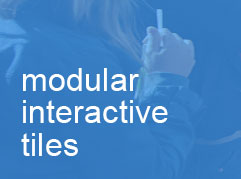
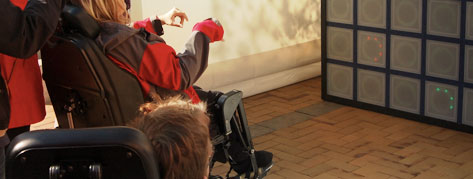






 Cardiovascular diseases including stroke are strongly correlated to age and are foreseen to be the leading cause of disablement among the elderly in the years to come. 90% of stroke patients are older than 60 years. European Governments aim to raise the average age for leaving work force, but this may be difficult to implement because the number of people who are forced to stop working prematurely due to stroke and other cardiovascular diseases is set to double over the next 25 years. Stroke is the most important cause of morbidity and long-term disability in Europe and imposes an enormous economic burden. The prevalence of European citizens now suffering from stroke is estimated at 1.13 million people. Lifetime costs per patient after a stroke span from $73,000 in Sweden to $37,000 in the Netherlands.
Cardiovascular diseases including stroke are strongly correlated to age and are foreseen to be the leading cause of disablement among the elderly in the years to come. 90% of stroke patients are older than 60 years. European Governments aim to raise the average age for leaving work force, but this may be difficult to implement because the number of people who are forced to stop working prematurely due to stroke and other cardiovascular diseases is set to double over the next 25 years. Stroke is the most important cause of morbidity and long-term disability in Europe and imposes an enormous economic burden. The prevalence of European citizens now suffering from stroke is estimated at 1.13 million people. Lifetime costs per patient after a stroke span from $73,000 in Sweden to $37,000 in the Netherlands. Common consequences of stroke includes weakness or paralysis of one side of the body, balance problems, vision impairments, speech disorders and problems with attention span, memory loss and problem solving. Two weeks after a stroke up to 60% of patients require some assistance daily, while 40% of stroke patients need active rehabilitation services. It is recommended that active rehabilitation should be administered to the patients as long as objective improvement is observed in their neurological function. However, current standard multi-disciplinary stroke rehabilitation treatment is labour-intensive, requiring one-to-one manual interactions with therapists. One-to-one physiotherapy and speech therapy have been the traditional rehabilitation. These are expensive treatments compounded by the fact there is already a shortage of trained physio- and speech therapists in most countries. Therefore it is difficult to provide highly intensive treatment for all patients. The result is that when treatment is reduced or stopped and the patient is left to continue unsupervised, the functions deteriorate. According to Roth and Harvey, patients can benefit greatly from training in therapeutic environments that reflect their natural homes or communities. In this environment the training effort can be focused and the patient will be less distracted by external stimuli. Early discharge from hospital after a stroke incident with rehabilitation at home has shown to be beneficial for patients being mildly to moderately impaired. An early
discharge will also reduce the cost of hospitalization.
Common consequences of stroke includes weakness or paralysis of one side of the body, balance problems, vision impairments, speech disorders and problems with attention span, memory loss and problem solving. Two weeks after a stroke up to 60% of patients require some assistance daily, while 40% of stroke patients need active rehabilitation services. It is recommended that active rehabilitation should be administered to the patients as long as objective improvement is observed in their neurological function. However, current standard multi-disciplinary stroke rehabilitation treatment is labour-intensive, requiring one-to-one manual interactions with therapists. One-to-one physiotherapy and speech therapy have been the traditional rehabilitation. These are expensive treatments compounded by the fact there is already a shortage of trained physio- and speech therapists in most countries. Therefore it is difficult to provide highly intensive treatment for all patients. The result is that when treatment is reduced or stopped and the patient is left to continue unsupervised, the functions deteriorate. According to Roth and Harvey, patients can benefit greatly from training in therapeutic environments that reflect their natural homes or communities. In this environment the training effort can be focused and the patient will be less distracted by external stimuli. Early discharge from hospital after a stroke incident with rehabilitation at home has shown to be beneficial for patients being mildly to moderately impaired. An early
discharge will also reduce the cost of hospitalization.



